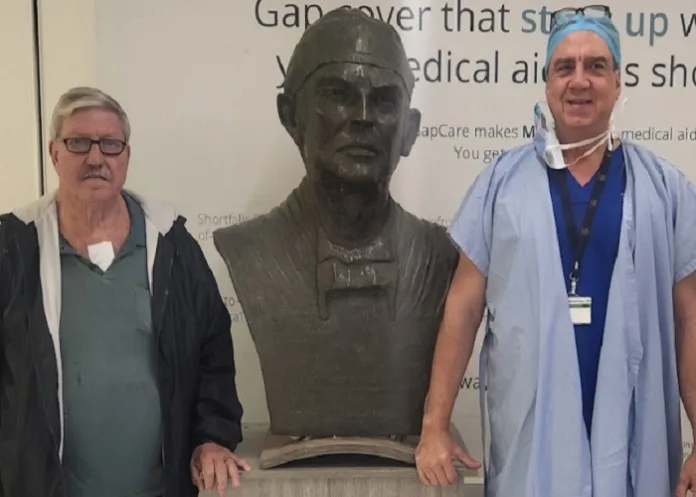In an echo of a visit more than 60 years ago, East London’s Joseph Jordaan (68) recently returned to an operating theatre in Cape Town where in 1962, as a six-year-old, he had been given a new lease on life by world famous cardiac surgeon Professor Chris Barnard.
This time, writes MedicalBrief, Jordaan underwent a procedure at the Netcare Christiaan Barnard Memorial Hospital, built in tribute to the surgeon whose skilled hands had saved his life as a child.
Jordaan was born with a congenital heart defect – which led to him and his mother, Sarah, making the trip to Groote Schuur Hospital at a time when advances in heart surgery were limited. They were unaware global cardiac care was on the precipice of a quantum leap.
In the same hospital, the world’s first human-to-human heart transplant would be performed less than five years later on 3 December 1967 by Barnard, who also performed the ventricular septal defect repair to the hole in Jordaan’s heart.
“It was a profoundly moving moment as my colleagues and I stood in the operating theatre at Netcare Christiaan Barnard Memorial Hospital to perform Joe’s second heart procedure,” said world-renowned cardiac and transplant surgeon Dr Willie Koen.
“There was almost no evidence of the surgery performed by Prof Barnard 61 years ago to repair the hole in Joe’s heart. The work was meticulous, and to this day, it continues to serve Joe well. This time, we were working on a different heart-related modification to replace a valve, close to the septum where the hole in his heart had been repaired.
“It was awe-inspiring knowing that the work of this incredible surgeon – who had operated on this same heart using very different technology more than six decades ago – lived on 22 years after his death. What an incredible legacy …”
A few days after his procedure, Jordaan he was doing “one hundred percent” well.
“My first heart procedure lasted me a lifetime, during which I married, gained three stepchildren and a daughter of my own. I was living well, eating and drinking like everyone else. Along the way I have had a few health scares which among others, resulted in having 36cm centimetres of my colon removed. I also had two hip replacements. Nowadays, I watch what I eat and I don’t drink.”
Koen said ventricular septal defect repair, even by today’s standards, can be a complex and difficult procedure. Back in 1962, it would take several hours, and in Jordaan’s case – because of complications brought on by the complexity of the procedure – it resulted in two operations of six and eight hours, respectively, in the space of a single day.
Jordaan spent more than a month in hospital after the procedure.
At the time, repairing a hole in the heart typically involved open-heart surgery. A large incision, often in the chest area, would be made to access the heart. In some cases, a sternotomy, which involved splitting the breastbone, was necessary to gain access.
To temporarily take over the heart's circulatory function, a heart-lung machine (cardiopulmonary bypass) would be connected to the patient. This machine would oxygenate the blood and pump it throughout the body while the heart was stopped.
With the heart still and blood flow diverted through the bypass machine, the surgeon would carefully locate and repair the hole in the heart using various techniques involving sutures, patches or other materials to close the hole.
Once the heart was successfully repaired, the heart-lung machine would be gradually withdrawn, allowing the heart to regain its natural pumping function. The chest incision would then be closed with sutures or staples.
“It's important to note that surgical techniques and equipment have evolved significantly since 1962,” said Koen.
“Today, most heart surgeries can be performed using minimally invasive approaches, reducing the need for large incisions and the use of a heart-lung machine in some cases.
“Nowadays, open-heart surgeries, which are almost a routine procedure, usually require a hospital stay of four to five days. Once you're discharged from the hospital, it can take six to eight weeks for your breastbone and chest muscles to heal as you gradually return to your normal daily routine.
“I think we underestimate the enormous evolution of cardiac surgery and how far we have come.
“It’s only when you look at the life of Joe Jordaan, and how he would not have seen adulthood if not for the procedure performed by Barnard all those years ago, and the fact that he has now been given a second lease on life once more, that you fully understand the value and tremendous impact of cardiac surgery.”
See more from MedicalBrief archives:
How a historic heart transplant created SA’s first celebrity scientist 50 years ago
Operational mitral valve implanted by Chris Barnard in 1969 found in Italian woman
Chris Barnard centenary birthday a reminder of SA’s current cardiovascular burden – Gray

